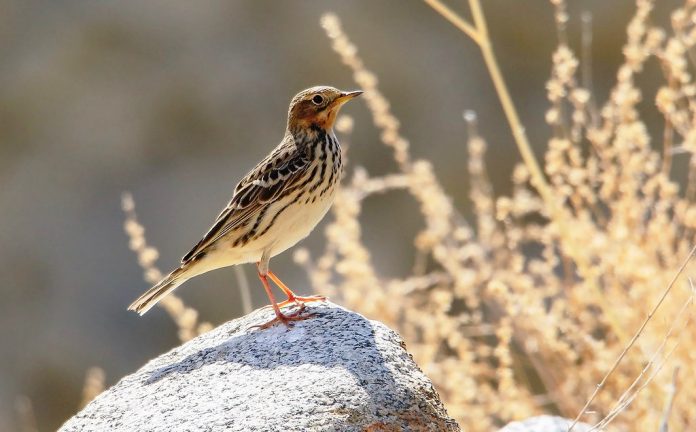IDENTIFICATION – The Red-throated pipit (Anthus cervinus) size is about 14-15 cm in length. This pipit is slightly plumper and shorter-tailed than Meadow Pipit, with a very different call, in fresh plumage tertials cloak primaries (unlike Pechora). The legs are yellowish-pink, hind-claw long.
Rump and uppertail coverts streaked in all plumage (a feature shared only by the similar Pechora, but beware of very worn Meadow Pipits in mid-summer with weakly streaked rumps). Most summer adults are easily identified by extensive brick-red or at least pinkish throat and face, reddish or pinkish extending onto breast and supercilium in the brightest birds, the reddish or pinkish coloration also being retained (usually in reduced intensity) by most adults in winter.
However, bright Tree Pipits have very warm buff throats and occasional aberrant Meadow Pipits with pinkish or reddish throats have occurred, but in Red-throated pipit the breast streaking is reduced by the reddish coloration.

In other plumage resemble Meadow or Tree, but underparts more heavily and broadly striped than in either, with long, wide stripes extending along the full length of flanks, and upperparts also darker and more strongly striped, with pale buff ‘braces’ on the mantle (like Pechora, and often weakly present on Meadow); in heavily worn plumage, the ‘braces’ disappear and the black stripes almost merge to give a very dark appearance.
Some heavily marked Meadows and fresh 1st-winter (or occasionally adult) Red-throated with warm buff or even whitish throats can appear very similar; with such birds, presence or absence of obvious rump streaking and calls should clinch identity.
In-flight appears slightly plumper and shorter-tailed than Meadow, and rump streaking may be visible on flushing; invariably calls in flight. Moreover, the less skulking than Tree, feeding in open likes Meadow. It is sociable, forming small flocks on migration. Typically, looks very similar to much less widespread Pechora Pipit.

SEX/AGE – Red-throated pipit both sexes are similar, although males typically have deeper and more extensive reddish or pinkish than females; many females and some males may lack reddish or pinkish altogether. The bird is the intensity of reddish or pinkish-reduced in the winter plumage. The juvenile resembles an adult but lacks any reddish or pinkish on the face and throat, and the background color of upper parts is colder, less buffish, and brown. The first winter is similar, background-color wearing whiter below, but not distinguishable from those adults that lack reddish or pinkish on the throat.
VOICE – Red-throated pipit typical flight call an extended, thin, plaintive, penetrating, high-pitched ‘seeeeeee’. It is fading towards the end, not unlike the call of Tree and Olive-backed, but longer, thinner, and lacking any hoarse quality; it has been likened to a short blast on a dog-whistle. Another call heard more rarely, is a low ‘chup’.
On breeding grounds, may give a dry ‘tsweep’ of alarm. Song somewhat intermediate between those of Meadow and Tree Pipits, but lacking terminal ‘swee-ur’ phrases of latter; a series of rising notes followed by a bubbling trill, given in song flight or in more subdued form from the ground.
HABITAT – Red-throated pipit is locally common (but less numerous in the west of range). (In addition to mapped range, has bred S Norway.) The pipit breeds in swampy meadows and boggy tundra, with low willow and birch scrub. On passage or in winter favors open cultivation, fallow fields, muddy flats, and short grass meadows, especially near water.
Related Reading – American pipit (Anthus rubescens)







